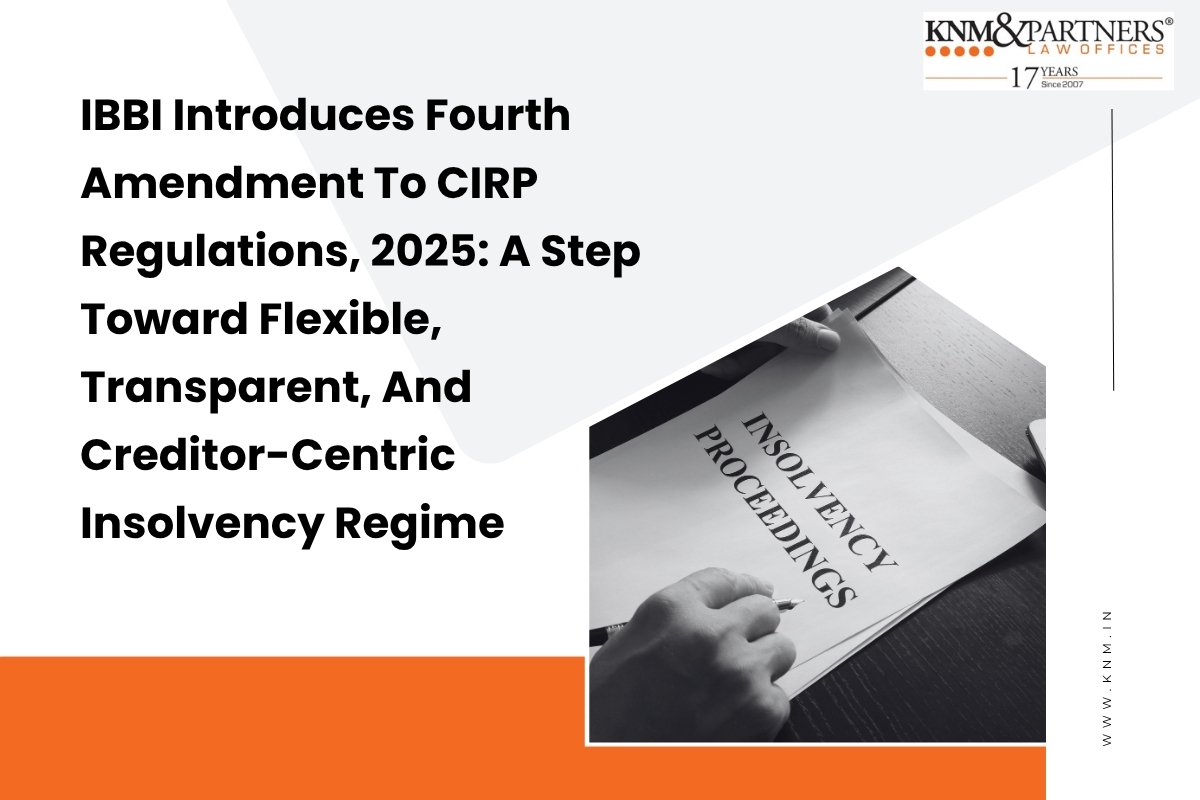In a significant development in India’s insolvency framework, the Insolvency and Bankruptcy Board of India (“IBBI”) has notified the Insolvency and Bankruptcy Board of India (Insolvency Resolution Process for Corporate Persons) (Fourth Amendment) Regulations, 2025 (“Amendment”) on May 26, 2025, with immediate effect.
The amendment marks a progressive reform aimed at enhancing procedural flexibility, creditor protection, and overall efficiency in the Corporate Insolvency Resolution Process (“CIRP”) under the Insolvency and Bankruptcy Code, 2016 (“IBC”).
Key Amendments And Its Legal Implications
Flexibility In Structure Of Resolution Plans
The amended framework empowers Resolution Professionals (“RPs”), with the prior approval of the Committee of Creditors (“CoC”), to invite Expressions of Interest (“EOIs”) in any of the following formats:
- For resolution of the Corporate Debtor as a whole;
- For sale of one or more assets of the Corporate Debtor; or
- A hybrid structure, combining both approaches.
This structural flexibility would help meeting the objection of IBC which is maximization of assets of Corporate Debtor and would Positive Impacts:
Maximizing Realizable Value through Segment-Specific Resolution
The introduction of asset-wise or segment-specific resolution strategies under the amended framework marks a strategic alignment with global best practices—particularly the Chapter 11 framework in the United States, which permits piecemeal or segmental sales.
The same will allow the CoC to extract maximum value from viable verticals of a distressed company. For instance, in conglomerates operating across real estate, manufacturing, or retail, unlocking value from profitable divisions while isolating loss-making ones can significantly enhance overall recovery.
Broadening the Investor Spectrum
The amendment would permit Resolution Applicants to bid for specific assets or business units—rather than mandating a resolution for the entire corporate debtor—widens the pool of potential investors. This reform particularly incentivizes strategic investors, private equity funds, and sector-specific buyers who may be interested only in select assets or geographies. A broader investor base fosters greater competition, driving better valuation and resolution outcomes.
Facilitating Speedier and Targeted Resolution
Segment-wise resolution also aids in avoiding delays associated with attempting a monolithic revival of an entity burdened by underperforming assets. In industries like real estate, where certain projects may be nearing completion and others are stalled or financially unviable, this flexibility ensures that successful or saleable projects are resolved and monetized expeditiously. This enables continuity of viable businesses, faster realization for creditors, and mitigation of value erosion during prolonged insolvency proceedings.
Challenges and Implementation Risks
While the aforesaid amendment introduces much-needed flexibility, their implementation may give rise to the following complexities and legal concerns:
Valuation Complexities
Segment-specific resolution necessitates precise valuation of individual assets—including intangible assets like brand equity, goodwill, or intellectual property. The absence of standardized methodologies for such valuation may lead to disputes, reduced recoveries, or subsequent litigation by stakeholders challenging the fairness of the asset pricing process.
Fragmentation Risks
Permitting asset-wise resolution increases the risk of fragmenting the insolvency process. The CoC and Resolution Professional (RP) may be compelled to manage multiple, disjointed resolution plans simultaneously. If viable assets are resolved but non-viable divisions remain, the company may face partial liquidation, defeating the objective of holistic corporate revival.
Increase in Potential Disputes among Creditors
The division of assets may exacerbate tensions among creditors, particularly operational creditors and minority financial creditors, who may perceive unequal treatment or fear erosion in value of their respective claims. Such perceived inequities may lead to challenges before the Adjudicating Authority, delaying final approval of the plan.
Absence of Clear Asset Segmentation Criteria
The regulations currently lack defined parameters for how assets or segments should be delineated for separate resolution. This may result in subjective or arbitrary segmentation, creating a fertile ground for legal challenges. Additionally, there is a regulatory risk of abuse—particularly in real estate—where developers might selectively push only profitable projects into resolution while deflecting the burden of distressed ones onto the CoC or the liquidation pool.
Ambiguity in Handling Residual Assets
The amendment does not clarify whether unsold or unresolved assets can be referred to liquidation while other segments proceed through resolution. This regulatory silence can give rise to conflicting interpretations about the finality or completeness of a resolution plan and may impede the CoC’s ability to expedite disposal of residual assets.
Increased Coordination Burden and Procedural Delays
Managing multiple bidders, resolution applicants, and segregated plans increases the complexity of the CIRP. The RP is burdened with heightened due diligence, negotiation, and compliance tasks, which may stretch timelines and jeopardize adherence to the statutory 180/270-day deadlines under the IBC. The likelihood of procedural bottlenecks is particularly high in cases involving multiple stakeholders and asset classes.
Participation Of Interim Finance Providers In COC Meetings
The Amendment allows the CoC to invite providers of interim finance to attend its meetings as observers without voting rights. This step promotes greater transparency and allows such financial institutions to assess the ongoing CIRP more accurately, fostering quicker and more informed decision-making on interim funding.
Equitable Treatment Of Dissenting Financial Creditors
The amendment mandate priority and pro rata payment to dissenting financial creditors—those who voted against the resolution plan—over consenting creditors in phased disbursements.
Thus, the amendment seeks to balance the commercial viability of staged payment structures with equitable creditor treatment, thus enhancing creditor protection under Section 30(2)(b) of the Code.
This revision is intended to safeguard dissenting creditors’ rights and reflects the IBC’s emphasis on fairness, taking cues from precedent-setting cases like Essar Steel India Limited v. Satish Kumar Gupta and Other.Mandatory Tabling Of All Resolution Plans Before COC
A significant change is the revision of Regulation 39(2), which now mandates requires the RP to place all resolution plans received—including those non-compliant with the Code or regulations—before the CoC.
The prior discretion of the RP to exclude non-compliant plans has been expressly omitted. The same shall ensure:- Transparency in plan evaluation;
- Information symmetry among CoC members;
- A possibility to identify the commercial potential in plans that may otherwise be dismissed on procedural grounds;
- Remove scope of any personal biasness of the RP in respect of a Resolution Applicant.
While the above change early-stage burdens and allows the CoC to consider diverse proposals, which might otherwise be dismissed on procedural grounds. It can also speed up the initial phases of the process.
However, with the recent decision of the Hon’ble Supreme Court in Bhushan Steels, the same introduces the risk that non-compliant plans may later be contested or rejected by the adjudicating authority, creating inefficiencies and overloading the NCLT particularly when in Bhushan Steels did not agree to Coc Autonomy.
Broader Impact
These amendments are aligned with international best practices in Insolvency law and mark a notable shift toward a more flexible, inclusive, and efficient resolution ecosystem in India. In particular, the reforms are expected to (a) bolster creditor confidence; (b) encourage diverse and targeted investor participation; (c) enhance procedural transparency and accountability; and (d) promote timely, fair, and commercially sound resolution outcomes.
Conclusion
The Fourth Amendment Regulations of 2025 reflect IBBI’s evolving approach in refining India’s insolvency law. By empowering stakeholders with greater clarity and flexibility, and by fortifying the creditor protection regime, these changes are poised to support the resolution of distressed assets in a time-bound and value-maximizing manner.








